Road Traffic Emission Inventory in an Urban Zone of West Africa: Case of Yopougon City (Abidjan, Côte d’Ivoire)
Abstract
:1. Introduction
2. Methodology and Data
2.1. Vehicle Emission
- Eps (in g/h) is the emission of a pollutant (p) on a road segment (s),
- At,s (in kg) is the total fuel consumption of vehicle type or category (t) over a road segment (s),
- EFpt,f (in g/kg), the emission factor of a giving pollutant (p), vehicle type (t), using a giving fuel (f),
- Ct,s (in L/h.veh) is the fuel consumption (amount of fuel used) for a particular type of vehicle (t) over a given road segment (s),
- TVt,s (veh/h) is the number of vehicles involved in circulation or traffic volume of vehicle type (t) and per road segment (s), ρf (in kg/m3) is the fuel density at fuel (f),
- Ct,day (L/d.veh) is the daily consumption for a particular type of vehicle during a given traveling time determined from the field campaign [26],
- tt,p (in seconds) is the average travel time of vehicle type [26], tt,s (in seconds) is the time of passage of the vehicle time on a given road segment
- Ls (km) is the length of a given road segment
- Vav,t,s (in km/h) is the average running speed over a road segment.
2.2. Study Area and Data
3. Results and Discussion
3.1. Vehicle Emission Inventory by Road Segment
3.2. Road Traffic Emission Inventory in Yopougon
3.3. Contribution to Emissions per Vehicle Type
3.4. Contribution to Emissions per Vehicle and Road Type
3.5. Spatial and Temporal Variation of Vehicle Emissions
3.6. Comparison with Other Emission Inventories
4. Conclusions
Author Contributions
Funding
Acknowledgments
Conflicts of Interest
References
- Konare, A.; Zakey, A.S.; Solmon, F.; Giorgi, F.; Rauscher, S.; Ibrah, S.; Bi, X. A regional climate modeling study of the effect of desert dust on the west african monsoon. J. Geophys. Res. Atmos. 2008, 113. [Google Scholar] [CrossRef]
- Solmon, F.; Mallet, M.; Elguindi, N.; Giorgi, F.; Zakey, A.; Konaré, A. Dust aerosol impact on regional precipitation over western Africa, mechanisms and sensitivity to absorption properties. Geophys. Res. Lett. 2008, 35. [Google Scholar] [CrossRef]
- Touré, N.; Konaré, A.; Silué, S. Intercontinental transport and climatic impact of saharan and sahelian dust. Adv. Meteorol. 2012, 2012. [Google Scholar] [CrossRef]
- Silue, S.; Konare, A.; Diedhiou, A.; Yoboue, V.; Toure, D.E.; Assamoi, P. Spatial and temporal variability of windborne dust in the Sahel-Sahara zone in relation with synoptic environment. Sci. Res. Essays 2013, 8, 705–717. [Google Scholar]
- Van der Werf, G.R.; Randerson, J.T.; Giglio, L.; Collatz, G.J.; Mu, M.; Kasibhatla, P.S.; Morton, D.C.; DeFries, R.S.; Jin, Y.V.; van Leeuwen, T.T. Global fire emissions and the contribution of deforestation, savanna, forest, agricultural and peat fires (1997–2009). Atmos. Chem. Phys. 2010, 10, 11707–11735. [Google Scholar] [CrossRef] [Green Version]
- Van der Werf, G.R.; Peters, W.; Van Leeuwen, T.T.; Giglio, L. What could have caused pre-industrial biomass burning emissions to exceed current rates? Clim. Past 2013, 9, 289–306. [Google Scholar] [CrossRef] [Green Version]
- Andela, N.; van der Werf, G.R. Recent trends in African fires driven by cropland expansion and El Niño to La Niña transition. Nat. Clim. Chang. 2014, 4, 791–795. [Google Scholar] [CrossRef]
- Liousse, C.; Galy-Lacaux, C.; Ndiaye, S.A.; Diop, B.; Ouafo, M.; Assamoi, E.M.; Gardrat, E.; Castera, P.; Rosset, R.; Akpo, A.; et al. Real time black carbon measurements in west and central Africa urban sites. Atmos. Environ. 2012, 54, 529–537. [Google Scholar]
- Wiedinmyer, C.; Akagi, S.K.; Yokelson, R.J.; Emmons, L.K.; Al-Saadi, J.A.; Orlando, J.J.; Soja, A.J. The fire INventory from NCAR (FINN): A high resolution global model to estimate the emissions from open burning. Geosci. Model. Dev. 2011, 4, 625. [Google Scholar] [CrossRef] [Green Version]
- N’Datchoh, E.T.; Diallo, I.; Konare, A.; Silue, S.; Ogunjobi, K.O.; Diedhiou, A.; Doumbia, M. Dust induced changes on the west African summer monsoon features. Int. J. Climatol. 2017, 38, 452–466. [Google Scholar] [CrossRef] [Green Version]
- Ichoku, C.; Ellison, L.T.; Willmot, K.E.; Matsui, T.; Dezfuli, A.K.; Gatebe, C.K.; Wang, J.; Wilcox, E.M.; Lee, J.; Adegoke, J.; et al. Biomass burning, land-cover change and the hydrological cycle in northern sub-Saharan Africa. Environ. Res. Lett. 2016, 11, 095005. [Google Scholar] [CrossRef] [Green Version]
- Assamoi, E.-M.; Liousse, C. A new inventory for two-wheel vehicle emissions in west Africa for 2002. Atmos. Environ. 2010, 44, 3985–3996. [Google Scholar] [CrossRef]
- Liousse, C.; Assamoi, E.; Criqui, P.; Granier, C.; Rosset, R. Explosive growth in African combustion emissions from 2005 to 2030. Environ. Res. Lett. 2014, 9, 035003. [Google Scholar] [CrossRef]
- Keita, S.; Liousse, C.; Assamoi, E.-M.; Doumbia, T.; Touré, N.; Gnamien, S.; Elguindi, N.; Granier, C.; Yoboué, V. African anthropogenic emissions inventory for gases and particles from 1990 to 2015. Earth Syst. Sci. Data Discuss. 2020, 1–29. [Google Scholar] [CrossRef]
- Keita, S.; Liousse, C.; Yoboú, V.; Dominutti, P.; Guinot, B.; Assamoi, E.M.; Borbon, A.; Haslett, S.L.; Bouvier, L.; Colomb, A. Particle and VOC emission factor measurements for anthropogenic sources in west Africa. Atmos. Chem. Phys. 2018, 18, 7691–7708. [Google Scholar] [CrossRef] [Green Version]
- Liousse, C. Updated African biomass burning emission inventories in the framework of the AMMA-IDAF program, with an evaluation of combustion aerosols. Atmos. Chem. Phys. 2010, 10, 9631–9646. [Google Scholar] [CrossRef] [Green Version]
- Laborde, M.; Crippa, M.; Tritscher, T.; Jurányi, Z.; Decarlo, P.F.; Temime-Roussel, B.; Marchand, N.; Eckhardt, S.; Stohl, A.; Baltensperger, U. Black carbon physical properties and mixing state in the European megacity Paris. Atmos. Chem. Phys. 2013, 13, 5831–5856. [Google Scholar] [CrossRef] [Green Version]
- Freney, E.J.; Sellegri, K.; Canonaco, F.; Colomb, A.; Borbon, A.; Michoud, V.; Doussin, J.-F.; Crumeyrolle, S.; Amarouche, N.; Pichon, J.-M.; et al. Characterizing the impact of urban emissions on regional aerosol particles: Airborne measurements during the MEGAPOLI experiment. Atmos. Chem. Phys. 2014, 14, 1397–1412. [Google Scholar] [CrossRef] [Green Version]
- Huang, X.; Song, Y.; Zhao, C.; Cai, X.; Zhang, H.; Zhu, T. Direct radiative effect by multicomponent aerosol over China. J. Clim. 2015, 28, 3472–3495. [Google Scholar] [CrossRef]
- Pu, W.; Wang, X.; Zhang, X.; Ren, Y.; Shi, J.-S.; Bi, J.-R.; Zhang, B.-D. Size distribution and optical properties of particulate matter (PM10) and black carbon (BC) during dust storms and local air pollution events across a loess plateau site. Aerosol Air Qual. Res. 2015, 15, 2212–2224. [Google Scholar] [CrossRef] [Green Version]
- Wang, Q.; Huang, R.-J.; Cao, J.; Tie, X.; Shen, Z.; Zhao, S.; Han, Y.; Li, G.; Li, Z.; Ni, H.; et al. Contribution of regional transport to the black carbon aerosol during winter haze period in Beijing. Atmos. Environ. 2016, 132, 11–18. [Google Scholar] [CrossRef]
- Oguntoke, O.; Yussuf, A.S. Air pollution arising from vehicular emissions and the associated human health problems in abeokuta metropolis, Nigeria. Asset Int. J. Ser. A 2008, 8, 119–132. [Google Scholar]
- Ekpenyong, C.E.; Ettebong, E.O.; Akpan, E.E.; Samson, T.K.; Daniel, N.E. Urban city transportation mode and respiratory health effect of air pollution: A cross-sectional study among transit and non-transit workers in Nigeria. BMJ Open 2012, 2, e001253. [Google Scholar] [CrossRef] [Green Version]
- Ndoke, P.N.; Jimoh, O.D. Impact of Traffic Emission on Air Quality in a Developing City of Nigeria. Available online: http://www.journal.au.edu/au_techno/2005/apr05/vol8no4_abstract10.pdf (accessed on 30 January 2021).
- Naidja, L.; Ali-Khodja, H.; Khardi, S. Particulate matter from road traffic in Africa. J. Earth Sci. Geotech. Eng. 2017, 7, 289–304. [Google Scholar]
- Doumbia, M.; Toure, N.; Silue, S.; Yoboue, V.; Diedhiou, A.; Hauhouot, C. Emissions from the road traffic of west African cities: Assessment of vehicle fleet and fuel consumption. Energies 2018, 11, 2300. [Google Scholar] [CrossRef] [Green Version]
- Hopkins, J.R.; Evans, M.J.; Lee, J.D.; Lewis, A.C.; Marsham, J.H.; McQuaid, J.B.; Parker, D.J.; Stewart, D.J.; Reeves, C.E.; Purvis, R.M. Direct estimates of emissions from the megacity of Lagos. Atmos. Chem. Phys. 2009, 9, 8471–8477. [Google Scholar] [CrossRef] [Green Version]
- Armah, F.A.; Yawson, D.O.; Pappoe, A.A. A systems dynamics approach to explore traffic congestion and air pollution link in the city of Accra, Ghana. Sustainability 2010, 2, 252–265. [Google Scholar] [CrossRef] [Green Version]
- Ameh, J.A.; Tor-Anyiin, T.A.; Eneji, I.S. Assessment of some gaseous emissions in traffic areas in Makurdi metropolis, Benue State, Nigeria. Open J. Air Pollut. 2015, 4, 175. [Google Scholar] [CrossRef] [Green Version]
- Moselakgomo, M.; Naidoo, M.; Letebele, M.O. The indicative effects of inefficient urban traffic flow on fuel cost and exhaust air pollutant emissions. In Proceedings of the 34th Annual Southern African Transport Conference, Pretoria, South Africa, 6–9 July 2015. [Google Scholar]
- Gnamien, S.; Yoboué, V.; Liousse, C.; Keita, S.; Bahino, J.; Siélé, S.; Diaby, L. Particulate pollution in Korhogo and Abidjan (Cote d’Ivoire) during the dry season. Aerosol Air Qual. Res. 2020, 21, 20020. [Google Scholar] [CrossRef]
- Alshetty, V.D.; Kuppili, S.K.; Nagendra, S.S.; Ramadurai, G.; Sethi, V.; Kumar, R.; Sharma, N.; Namdeo, A.; Bell, M.; Goodman, P. Characteristics of tail pipe (Nitric oxide) and resuspended dust emissions from urban roads–A case study in Delhi city. J. Transp. Health 2019, 17, 100653. [Google Scholar] [CrossRef]
- Goodrick, S.L.; Achtemeier, G.L.; Larkin, N.K.; Liu, Y.; Strand, T.M. Modelling smoke transport from wildland fires: A review. Int. J. Wildland Fire 2013, 22, 83. [Google Scholar] [CrossRef]
- Paugam, R.; Wooster, M.; Freitas, S.; Val Martin, M. A review of approaches to estimate wildfire plume injection height within large-scale atmospheric chemical transport models. Atmos. Chem. Phys. 2016, 16, 907–925. [Google Scholar] [CrossRef] [Green Version]
- Requia, W.J.; Higgins, C.D.; Adams, M.D.; Mohamed, M.; Koutrakis, P. The health impacts of weekday traffic: A health risk assessment of PM2. 5 emissions during congested periods. Environ. Int. 2018, 111, 164–176. [Google Scholar] [CrossRef] [PubMed]
- San José, R.; Pérez, J.L.; Pérez, L.; González, R.M.; Pecci, J.; Palacios, M. Forest fire forecasting tool for air quality modelling systems. Fís. Tierra 2015, 27, 69. [Google Scholar]
- Shekarrizfard, M.; Valois, M.-F.; Weichenthal, S.; Goldberg, M.S.; Fallah-Shorshani, M.; Cavellin, L.D.; Crouse, D.; Parent, M.-E.; Hatzopoulou, M. Investigating the effects of multiple exposure measures to traffic-related air pollution on the risk of breast and prostate cancer. J. Transp. Health 2018, 11, 34–46. [Google Scholar] [CrossRef]
- Zhang, K.; Batterman, S.; Dion, F. Vehicle emissions in congestion: Comparison of work zone, rush hour and free-flow conditions. Atmos. Environ. 2011, 45, 1929–1939. [Google Scholar] [CrossRef]
- Zhang, X.; Craft, E.; Zhang, K. Characterizing spatial variability of air pollution from vehicle traffic around the Houston ship channel area. Atmos. Environ. 2017, 161, 167–175. [Google Scholar] [CrossRef]
- Zhang, K.; Batterman, S. Air pollution and health risks due to vehicle traffic. Sci. Total Environ. 2013, 450, 307–316. [Google Scholar] [CrossRef] [Green Version]
- Huo, H.; Zhang, Q.; He, K.; Yao, Z.; Wang, X.; Zheng, B.; Streets, D.G.; Wang, Q.; Ding, Y. Modeling vehicle emissions in different types of Chinese cities: Importance of vehicle fleet and local features. Environ. Pollut. 2011, 159, 2954–2960. [Google Scholar] [CrossRef]
- Tan, J.; Zhang, Y.; Ma, W.; Yu, Q.; Wang, J.; Chen, L. Impact of spatial resolution on air quality simulation: A case study in a highly industrialized area in Shanghai, China. Atmos. Pollut. Res. 2015, 6, 322–333. [Google Scholar] [CrossRef] [Green Version]
- Allende, D.; Ruggeri, M.F.; Lana, B.; Garro, K.; Altamirano, J.; Puliafito, E. Inventory of primary emissions of selected persistent organic pollutants to the atmosphere in the area of Great Mendoza. Emerg. Contam. 2016, 2, 14–25. [Google Scholar] [CrossRef] [Green Version]
- Jing, B.; Wu, L.; Mao, H.; Gong, S.; He, J.; Zou, C.; Song, G.; Li, X.; Wu, Z. Development of a vehicle emission inventory with high temporal–spatial resolution based on NRT traffic data and its impact on air pollution in Beijing–Part 1: Development and evaluation of vehicle emission inventory. Atmos. Chem. Phys. 2016, 16, 3161–3170. [Google Scholar] [CrossRef] [Green Version]
- Zhou, Y.; Zhao, Y.; Mao, P.; Zhang, Q.; Zhang, J.; Qiu, L.; Yang, Y. Development of a high-resolution emission inventory and its evaluation and application through air quality modeling for Jiangsu province, China. Atmos. Chem. Phys. 2017, 17, 211–233. [Google Scholar] [CrossRef] [Green Version]
- Ponche, J.-L.; Vinuesa, J.-F. Emission scenarios for air quality management and applications at local and regional scales including the effects of the future European emission regulation (2015) for the upper Rhine Valley. Atmos. Chem. Phys. 2005, 5, 999–1014. [Google Scholar] [CrossRef] [Green Version]
- Abulude, F.O.; Bahloul, M.; Adeoya, E.A.; Olubayode, S.A. A review on top-down and bottom-up approaches for air pollution studies. Preprints 2017. [Google Scholar] [CrossRef] [Green Version]
- Wang, H.; Chen, C.; Huang, C.; Fu, L. On-road vehicle emission inventory and its uncertainty analysis for Shanghai, China. Sci. Total Environ. 2008, 398, 60–67. [Google Scholar] [CrossRef]
- Wang, H.; Fu, L.; Lin, X.; Zhou, Y.; Chen, J. A bottom-up methodology to estimate vehicle emissions for the Beijing urban area. Sci. Total Environ. 2009, 407, 1947–1953. [Google Scholar] [CrossRef]
- Zavala, M.; Herndon, S.C.; Wood, E.C.; Jayne, J.T.; Nelson, D.D.; Trimborn, A.M.; Dunlea, E.; Knighton, W.B.; Mendoza, A.; Allen, D.T.; et al. Comparison of emissions from on-road sources using a mobile laboratory under various driving and operational sampling modes. Atmos. Chem. Phys. 2009, 9, 1–14. [Google Scholar] [CrossRef] [Green Version]
- Mohan, M. Performance evaluation of AERMOD and ADMS-urban for total suspended particulate matter concentrations in megacity Delhi. Aerosol Air Qual. Res. 2011. [Google Scholar] [CrossRef] [Green Version]
- Timmermans, R.M.A.; Denier van der Gon, H.A.C.; Kuenen, J.J.P.; Segers, A.J.; Honoré, C.; Perrussel, O.; Builtjes, P.J.H.; Schaap, M. Quantification of the urban air pollution increment and its dependency on the use of down-scaled and bottom-up city emission inventories. Urban Clim. 2013, 6, 44–62. [Google Scholar] [CrossRef]
- Borge García, R.; de la Paz, D.; Lumbreras, J.; Pérez, J.; Vedrenne, M. Analysis of contributions to NO2 ambient air quality levels in Madrid city (Spain) through modeling. Implications for the development of policies and air quality monitoring. J. Geosci. Environ. Prot. 2014, 2, 6–11. [Google Scholar]
- Pallavidino, L.; Prandi, R.; Bertello, A.; Bracco, E.; Pavone, F. Compilation of a road transport emission inventory for the province of Turin: Advantages and key factors of a bottom–up approach. Atmos. Pollut. Res. 2014, 5, 648–655. [Google Scholar] [CrossRef] [Green Version]
- He, J.; Wu, L.; Mao, H.; Liu, H.; Jing, B.; Yu, Y.; Ren, P.; Feng, C.; Liu, X. Development of a vehicle emission inventory with high temporal–spatial resolution based on NRT traffic data and its impact on air pollution in Beijing–Part 2: Impact of vehicle emission on urban air quality. Atmos. Chem. Phys. 2016, 16, 3171–3184. [Google Scholar] [CrossRef] [Green Version]
- Cooke, W.F.; Liousse, C.; Cachier, H.; Feichter, J. Construction of a 1 × 1 fossil fuel emission data set for carbonaceous aerosol and implementation and radiative impact in the ECHAM4 model. J. Geophys. Res. Atmos. 1999, 104, 22137–22162. [Google Scholar] [CrossRef]
- Junker, C.; Liousse, C. A global emission inventory of carbonaceous aerosol from historic records of fossil fuel and biofuel consumption for the period 1860–1997. Atmos. Chem. Phys. 2008, 1–13. [Google Scholar]
- Friedrich, R.; Reis, S. Emissions of Air Pollutants: Measurements, Calculations and Uncertainties; Springer Science & Business Media: Berlin, Germany, 2013. [Google Scholar]
- Assamoi, A.Y.E.-M. Emissions Anthropiques d’Aérosols Carbonés en Afrique en 2005 et en 2030: Élaboration e’Inventaires et Évaluation. Ph.D. Thesis, Université Paul Sabatier-Toulouse III, Toulouse, France, 2011. [Google Scholar]
- Barros, N.; Fontes, T.; Silva, M.P.; Manso, M.C. How wide should be the adjacent area to an urban motorway to prevent potential health impacts from traffic emissions? Transp. Res. Part A: Policy Pract. 2013, 50, 113–128. [Google Scholar] [CrossRef]
- Ouarzazi, J.; Terhzaz, M.; Abdellaoui, A.; Bouhafid, A.; Nollet, V.; Dechaux, J.-C. Etude descriptive de La mesure de polluants atmospheriques dans l’agglomération de Marrakech. Pollut. Atmos. 2003, 2268–3798, 137–151. [Google Scholar] [CrossRef] [Green Version]
- Kansal, A.; Khare, M.; Sharma, C.S. Air quality modelling study to analyse the impact of the world bank emission guidelines for thermal power plants in Delhi. Atmos. Pollut. Res. 2011, 2, 99–105. [Google Scholar] [CrossRef] [Green Version]
- Sindhwani, R.; Goyal, P. Assessment of traffic-generated gaseous and particulate matter emissions and trends over Delhi (2000–2010). Atmos. Pollut. Res. 2014, 5, 438–446. [Google Scholar] [CrossRef] [Green Version]
- Höglund, P.G. Parking, energy consumption and air pollution. Sci. Total Environ. 2004, 334, 39–45. [Google Scholar] [CrossRef]
- Chinrungrueng, J.; Sunantachaikul, U.; Triamlumlerd, S. Smart parking: An application of optical wireless sensor network. In Proceedings of the 2007 International Symposium on Applications and the Internet Workshops, Hiroshima, Japan, 15–19 January 2007; p. 66. [Google Scholar]
- Coric, V.; Gruteser, M. Crowdsensing maps of on-street parking spaces. In Proceedings of the 2013 IEEE International Conference on Distributed Computing in Sensor Systems, Cambridge, MA, USA, 20–23 May 2013; pp. 115–122. [Google Scholar]
- Effiong, U.E. Air pollution emission inventory along a major traffic route within Ibadan metropolis, southwestern Nigeria. Afr. J. Environ. Sci. Technol. 2016, 10, 432–438. [Google Scholar] [CrossRef] [Green Version]
- Semakula, M.; Inambao, F. Biodiesel, Combustion, Performance and Emissions Characteristics; Springer Nature: London, UK, 2020. [Google Scholar]
- Chen, Y.; Borken-Kleefeld, J. NO x emissions from Diesel passenger cars worsen with age. Environ. Sci. Technol. 2016, 50, 3327–3332. [Google Scholar] [CrossRef] [PubMed] [Green Version]
- Chen, Y.; Sun, R.; Borken-Kleefeld, J. On-Road NO x and smoke emissions of Diesel light commercial vehicles–combining remote sensing measurements from across Europe. Environ. Sci. Technol. 2020, 54, 11744–11752. [Google Scholar] [CrossRef] [PubMed]
- Smith, T.R.; Kersey, V.; Bidwell, T. The effect of engine age, engine oil age and drain interval on vehicle tailpipe emissions and fuel efficiency. Sae Trans. 2001, 1838–1861. [Google Scholar]
- ATMOPACA. Les Emissions Dues aux Transports Routiers Note de Synthese Realisee dans le Cadre d’un Projet Soutenu par la Region PACA et la CPA. Available online: https://www.atmosud.org/sites/paca/files/atoms/files/081105_atmopaca_note_synthese_transport_colloque_ort.pdf (accessed on 30 January 2021).
- Pérez-Martínez, P.J.; Fátima Andrade, M.; Miranda, R.M. Traffic-related air quality trends in São Paulo, Brazil. J. Geophys. Res. Atmos. 2015, 120, 6290–6304. [Google Scholar] [CrossRef] [Green Version]
- Agyemang-Bonsu, K.W.; Dontwi, I.K.; Tutu-Benefoh, D.A.; Bentil, D.E.; Boateng, O.G.; Asuobonteng, K.; Agyemang, W. Traffic-data driven modelling of vehicular emissions using COPERT III in Ghana: A case study of Kumasi. Am. J. Sci. Ind. Res. 2010, 1, 32–40. [Google Scholar]
- Bahino, J.; Yoboué, V.; Galy-Lacaux, C.; Adon, M.; Akpo, A.; Keita, S.; Liousse, C.; Gardrat, E.; Chiron, C.; Ossohou, M. A pilot study of gaseous pollutants’ measurement (NO 2, SO 2, NH 3, HNO 3 and O 3) in Abidjan, Côte d’Ivoire: Contribution to an overview of gaseous pollution in African cities. Atmos. Chem. Phys. 2018, 18, 5173–5198. [Google Scholar] [CrossRef] [Green Version]
- Boularab, I.; Elghazi, I.; Mouhaddach, O.; Kestemont, M.-P.; El Jaafari, S. Analyse Spatiale de la Pollution Particulaire au Niveau de la Ville de Meknès (Maroc)/[Spatial Analysis of Particulate Air Pollution in Meknes City (Morocco)]. Int. J. Innov. Appl. Stud. 2015, 13, 781. [Google Scholar]
- Atmo PACA. Inventaire des Émissions Année de Référence 2004. Pollution Atmosphérique et Gaz à Effet de Serre. Available online: https://www.atmosud.org/sites/paca/files/publications_import/files/090223_AirPACA_Rapport_Inventaire_PACA_2004_V2009_net.pdf (accessed on 30 January 2021).
- Joumard, R. Les Enjeux de La Pollution de l’Air des Transports. In Proceedings of the Transports et Pollution de l’Air, Avignon, France, 16–18 June 2003; pp. 233–240. [Google Scholar]
- Kim Oanh, N.T.; Huynh, H.V.; Saikawa, E. Comparative analysis of passenger traffic fleets in Asian cities: Technology, driving activities and emission. In Proceedings of the AGU Fall Meeting Abstracts, San Francisco, CA, USA, 14–18 December 2015. [Google Scholar]
- Franco, J.F.; Rojas, N.Y.; Sarmiento, O.L.; Behrentz, E. Urban air pollution in school-related microenvironments in Bogota, Colombia. Ing. E Investig. 2013, 33, 42–48. [Google Scholar]
- Guinot, B.; Cachier, H.; Sciare, J.; Tong, Y.; Xin, W.; Jianhua, Y. Beijing aerosol: Atmospheric interactions and new trends. J. Geophys. Res. Atmos. 2007, 112. [Google Scholar] [CrossRef] [Green Version]
- Sandradewi, J.; Prévôt, A.S.; Szidat, S.; Perron, N.; Alfarra, M.R.; Lanz, V.A.; Weingartner, E.; Baltensperger, U. Using aerosol light absorption measurements for the quantitative determination of wood burning and traffic emission contributions to particulate matter. Environ. Sci. Technol. 2008, 42, 3316–3323. [Google Scholar] [CrossRef] [PubMed]
- Pio, C.; Cerqueira, M.; Harrison, R.M.; Nunes, T.; Mirante, F.; Alves, C.; Oliveira, C.; de la Campa, A.S.; Artíñano, B.; Matos, M. OC/EC ratio observations in Europe: Re-thinking the approach for apportionment between primary and secondary organic carbon. Atmos. Environ. 2011, 45, 6121–6132. [Google Scholar] [CrossRef]
- Bond, T.C.; Doherty, S.J.; Fahey, D.W.; Forster, P.M.; Berntsen, T.; DeAngelo, B.J.; Flanner, M.G.; Ghan, S.; Kärcher, B.; Koch, D. Bounding the role of black carbon in the climate system: A scientific assessment. J. Geophys. Res. Atmos. 2013, 118, 5380–5552. [Google Scholar] [CrossRef]
- Duprez, F. Les Coûts Sociaux du Système de Transports Urbains d’Abidjan (Côte d’Ivoire). Available online: http://dev.codatu.org/wp-content/uploads/Les-co%C3%BBts-sociaux-du-syst%C3%A8me-de-transports-urbains-dAbidjan-Cote-dIvoire-F.DUPREZ.pdf (accessed on 30 January 2021).
- Guézéré, A. Deux Roues Motorisées et Étalement Urbain à Lomé, Quel Lien avec la Théorie des «trois Âges» de la Ville? Norois. Environ. Aménage. Soc. 2013, 41–62. [Google Scholar] [CrossRef]
- Kumar, A.; Barrett, F. Stuck in traffic: Urban transport in Africa. In AICD Background Paper. Available online: https://www.eu-africa-infrastructure-tf.net/attachments/library/aicd-background-paper-1-urban-trans-summary-en.pdf (accessed on 30 January 2021).
- Pochet, P.; Olvera, L.D.; Plat, D.; Adolehoume, A. L’usage Privé et Public des Motos dans les Villes d’Afrique Sub-Saharienne. In Public Transport Trends 2017; UITP: Brussels, Belgium, 2017; pp. 103–105. [Google Scholar]
- Olvera, L.D.; Plat, D.; Pochet, P.; Maïdadi, S. Motorbike taxis in the “Transport Crisis” of west and central African cities. EchoGéo 2012, 20, 15. [Google Scholar] [CrossRef] [Green Version]
- Kan, Z.; Tang, L.; Kwan, M.-P.; Zhang, X. Estimating vehicle fuel consumption and emissions using GPS big data. Int. J. Environ. Res. Public Health 2018, 15, 566. [Google Scholar] [CrossRef] [Green Version]
- Sider, T.; Alam, A.; Zukari, M.; Dugum, H.; Goldstein, N.; Eluru, N.; Hatzopoulou, M. Land-use and socio-economics as determinants of traffic emissions and individual exposure to air pollution. J. Transp. Geogr. 2013, 33, 230–239. [Google Scholar] [CrossRef]
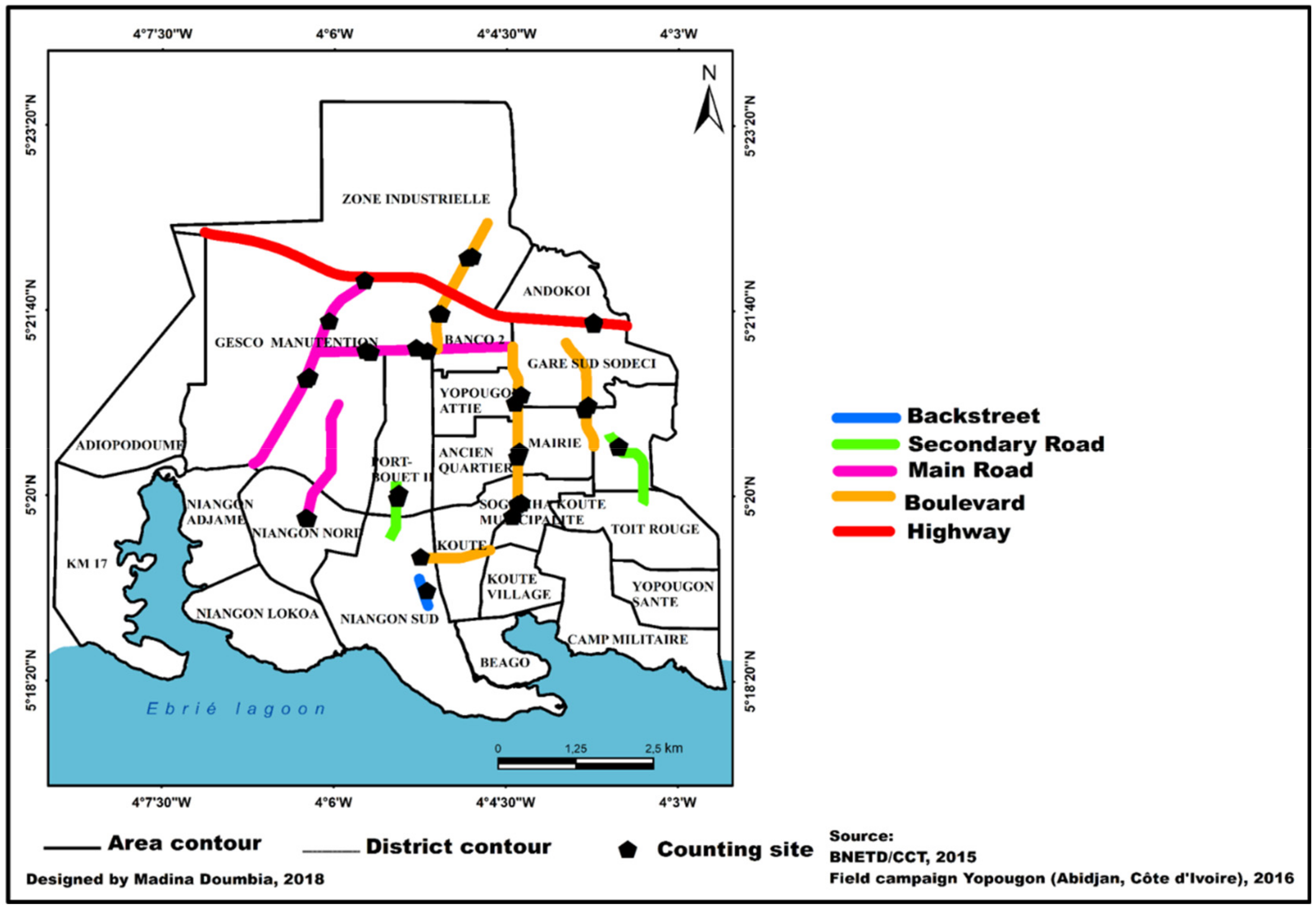

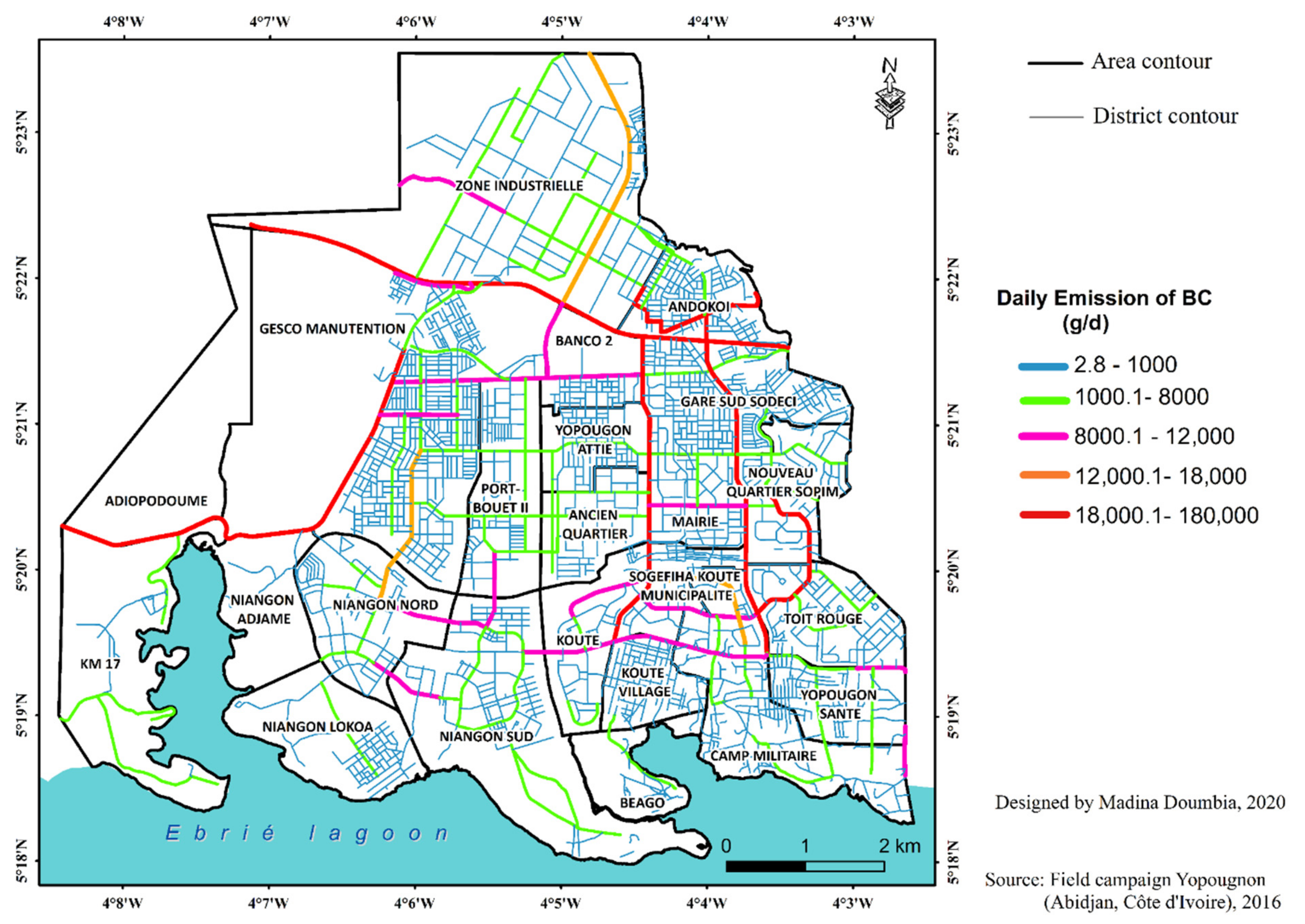
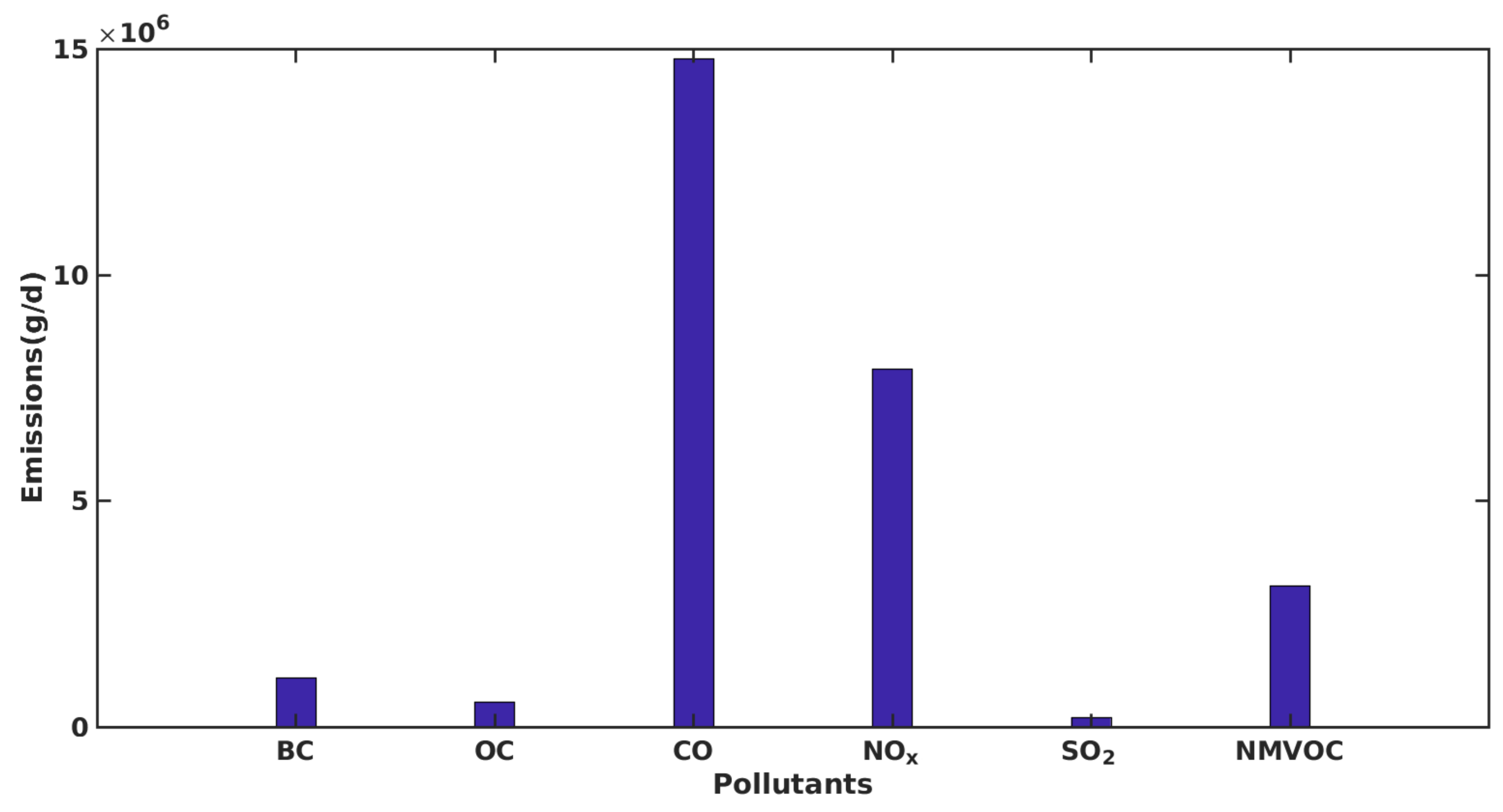
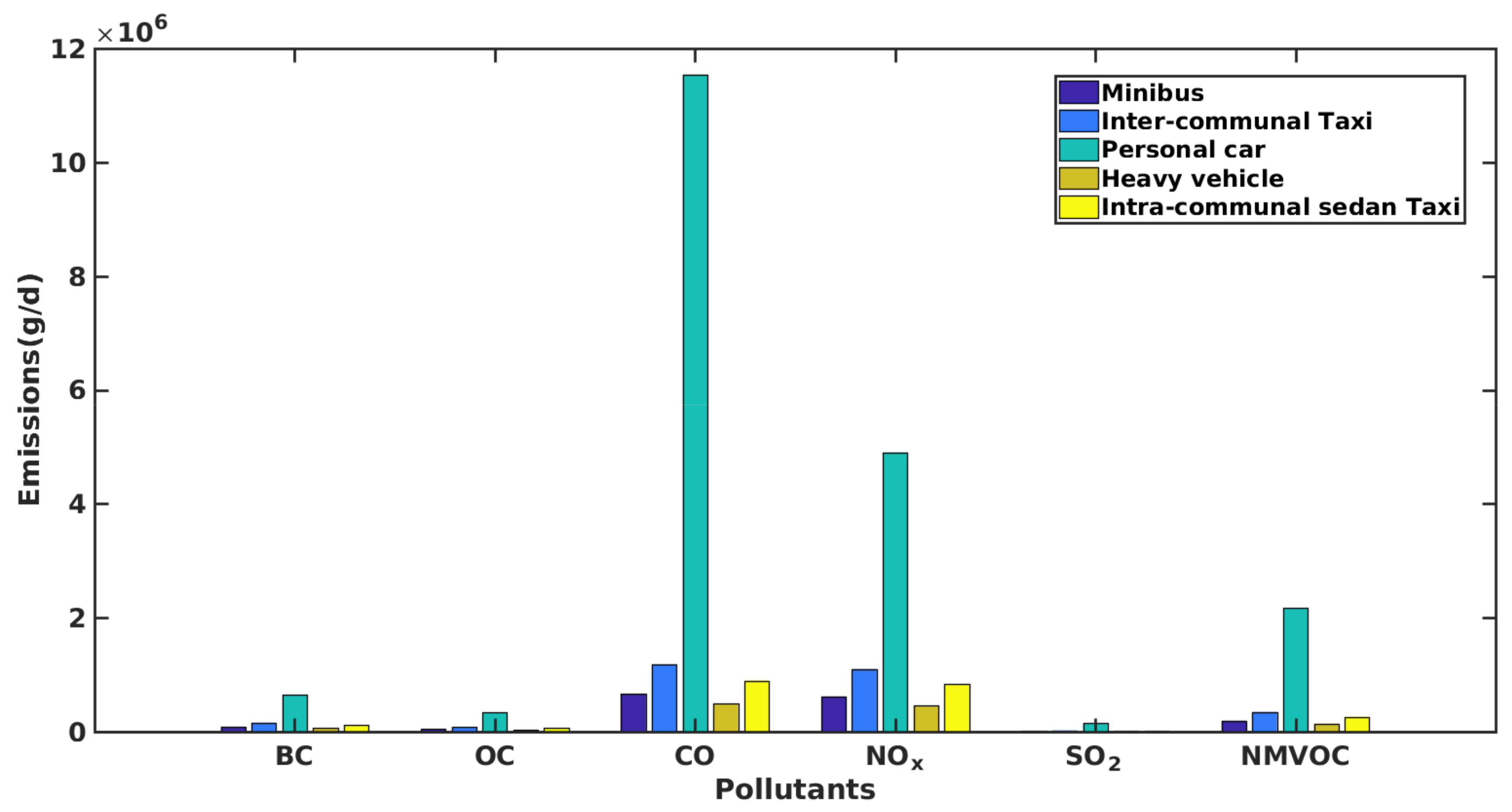
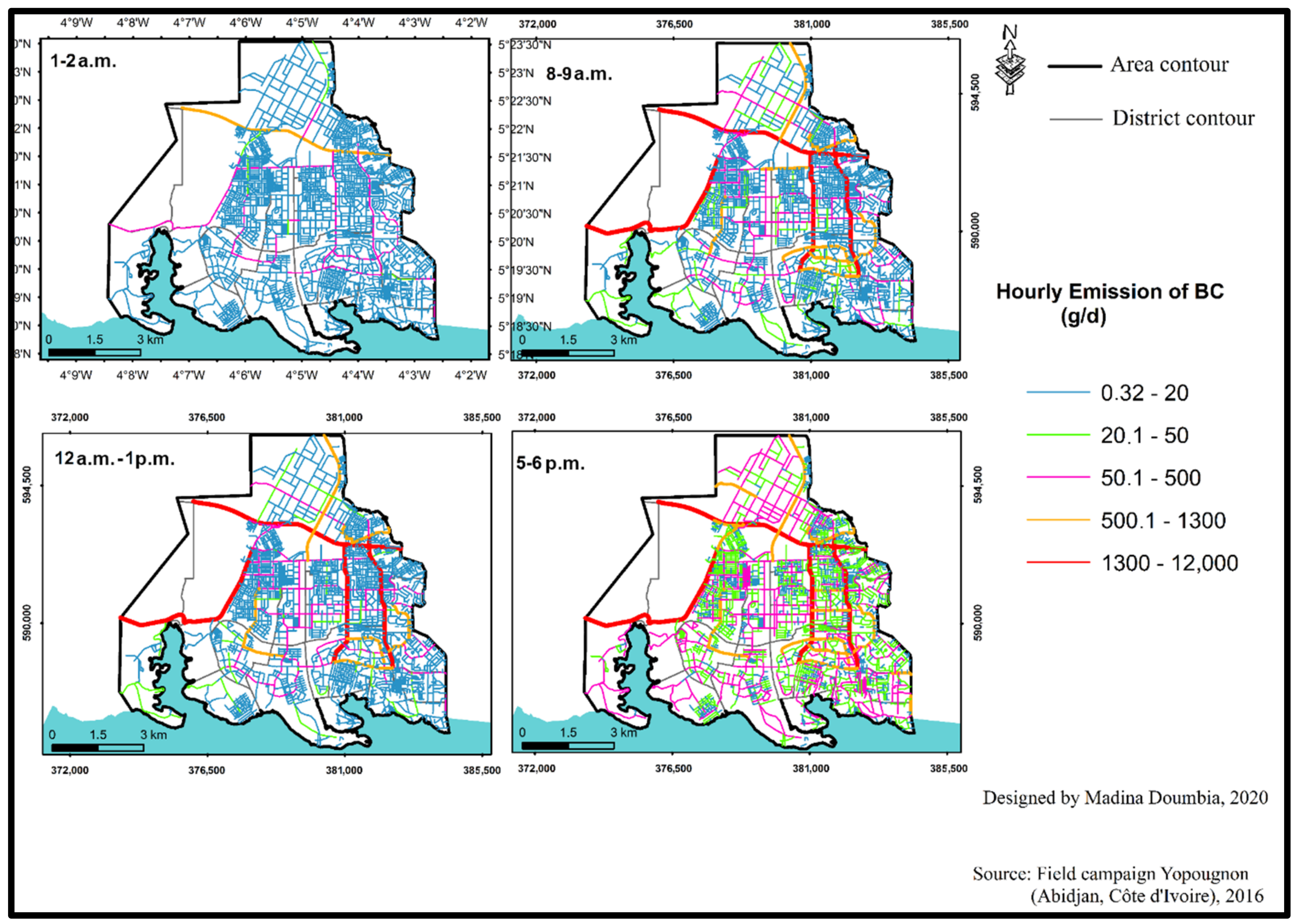
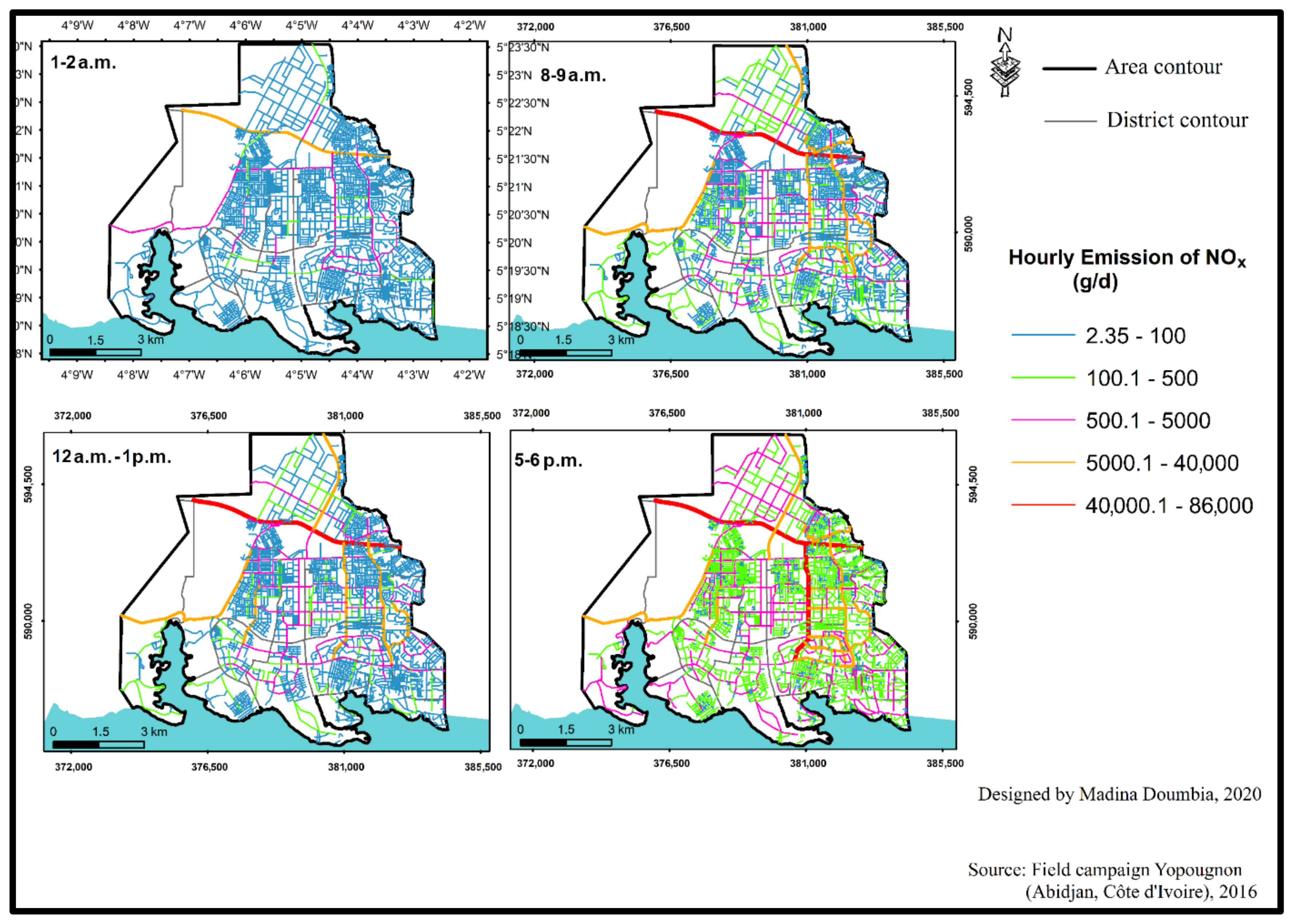
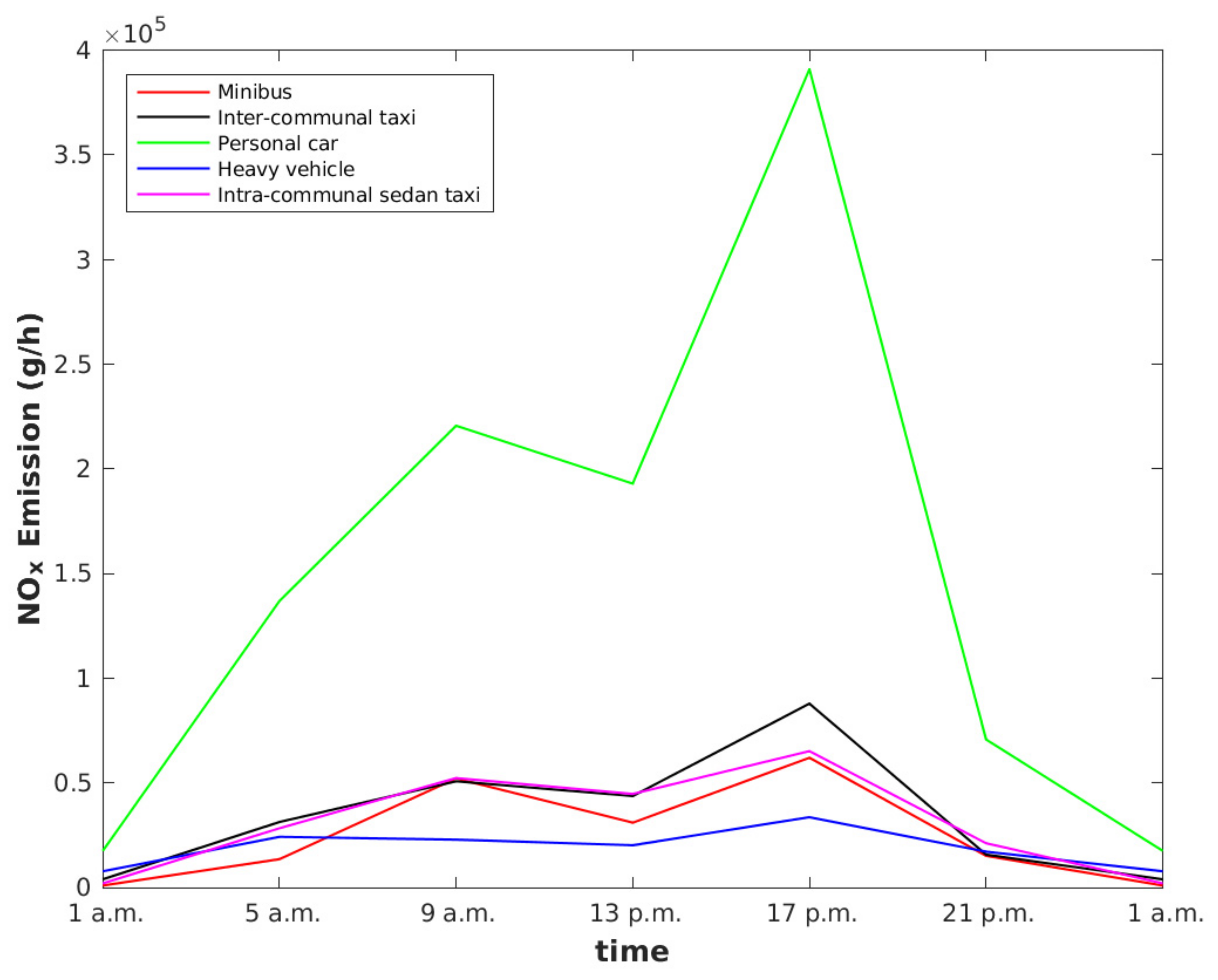
| EF (g/kg) | BC | OC | CO | NOx | SO2 | NMVOC | |
|---|---|---|---|---|---|---|---|
| Fuel | |||||||
| Diesel | 5.00 [13] 3.35 ± 2.20 (a) [15] 2.20 ± 1.05 (b) [15] | 2.50 [13] 2.03 ± 1.13 (a) [15] 2.5 ± 1.43 (b) | 37.00 [13] | 34.40 [13] | 0.72 [13] | 10.85 [13] | |
| Gasoline | 0.15 [13] 0.62 ± 0.49 (a) [15] | 0.73 [13] 1.1 ± 0.77(a) [15] | 300.00 [13] | 19.50 [13] | 2.36 [13] | 34.00 [13] | |
| Road Network | Road Name | EMISSIONS (g/d) | |||||||
|---|---|---|---|---|---|---|---|---|---|
| BC (a) | BC (b) | OC (a) | OC (b) | CO (a) | NOX (a) | SO2 (a) | NMVOC (a) | ||
| BO1 | 3ème pont-Zone Indus | 19,786.05 | 12,616.91 | 10,167.43 | 8803.34 | 267,924.66 | 143,635.83 | 3799.82 | 56,625.44 |
| BO2 | 40-St Pierre | 7938.98 | 5345.90 | 4064.55 | 3388.52 | 100,842.35 | 57,221.08 | 1472.54 | 21,970.10 |
| MR1 | Ant Annaneraie-CHU | 7575.22 | 5102.71 | 3899.14 | 3271.15 | 105,443.70 | 55,169.05 | 1477.22 | 22,002.43 |
| HW | Banco-1er Pont | 129,461.06 | 84,700.96 | 5699.93 | 4879.39 | 1,853,499.61 | 946,023.02 | 25,648.34 | 381,820.80 |
| BO3 | Crf Zone-3ème pont | 14,942.33 | 9775.22 | 7703.57 | 6593.96 | 213,481.14 | 109,161.79 | 2956.81 | 44,019.00 |
| MR2 | Crf Zone-CHU | 6010.40 | 4005.38 | 3075.53 | 2579.43 | 75,619.25 | 43,275.78 | 1109.14 | 16,551.22 |
| BO4 | Kenya-Wakouboué | 7441.67 | 4992.33 | 3803.32 | 3171.62 | 91,590.84 | 53,455.37 | 1357.34 | 20,263.24 |
| MR3 | Lubafrique-Antenne_Maroc | 5569.68 | 3746.97 | 2183.94 | 1827.80 | 74,161.54 | 40,355.11 | 1059.79 | 15,798.07 |
| SR1 | Mossikro-Nouveau Qrt | 10,281.60 | 6928.76 | 5294.97 | 4443.78 | 144,353.07 | 74,955.64 | 2014.66 | 30,002.63 |
| SR2 | Petro Ivoir-Texaco | 12,806.92 | 8605.58 | 6563.13 | 5485.44 | 165,474.77 | 92,480.27 | 2397.35 | 35,756.84 |
| MR4 | Rd Pt Gesco- Shell | 10,569.28 | 6985.08 | 5540.50 | 4712.61 | 150,798.87 | 77,201.62 | 2089.86 | 31,113.27 |
| MR5 | Rd Pt Gesco-Dabou | 15,236.09 | 10,108.17 | 7843.94 | 6645.52 | 212,772.30 | 111,004.71 | 2976.56 | 44,331.67 |
| BO5 | Sable-Bel Air | 9894.02 | 6642.94 | 5108.74 | 4311.11 | 144,829.73 | 72,495.77 | 1985.02 | 29,538.42 |
| BO6 | Siporex-Kenya | 10,842.30 | 7278.26 | 5535.54 | 4608.36 | 130,885.61 | 77,724.76 | 1957.58 | 29,234.57 |
| BO7 | Wakouboué-Sadiguiba | 8420.77 | 5657.86 | 4422.34 | 3695.53 | 108,448.55 | 60,785.52 | 1573.53 | 23,470.87 |
| BS | Ruelle | 365.86 | 248.90 | 72.48 | 60.82 | 5551.38 | 2692.82 | 74.93 | 1114.33 |
| Highway (HW) | Boulevard (BO) | Main Road (MR) | Secondary Road (SR) | Backstreet (BS) | ||
|---|---|---|---|---|---|---|
| BC | Personal car (PC) | 70.21 | 54.84 | 45.6 | 52.83 | 75.48 |
| IC Sedan Taxi (WR) | 0.43 | 14.76 | 20.74 | 16.23 | 2.48 | |
| IC Taxi (TA) | 13.16 | 11.04 | 15.21 | 13.29 | 18.25 | |
| Minibus (GB) | 6.4 | 12.48 | 11.65 | 10.46 | 2.29 | |
| Heavy Vehicle (HV) | 9.81 | 6.88 | 6.79 | 7.19 | 1.49 | |
| OC | Personal car (PC) | 71.12 | 55.93 | 46.7 | 53.92 | 76.29 |
| IC Sedan Taxi (WR) | 0.42 | 14.41 | 20.33 | 15.85 | 2.4 | |
| IC Taxi (TA) | 12.76 | 10.77 | 14.91 | 12.98 | 17.65 | |
| Minibus (GB) | 6.2 | 12.18 | 11.41 | 10.22 | 2.21 | |
| Heavy Vehicle (HV) | 9.5 | 6.72 | 6.66 | 7.02 | 1.44 | |
| CO | Personal car (PC) | 84.93 | 74.38 | 66.71 | 72.81 | 88.04 |
| IC Sedan Taxi (WR) | 0.22 | 8.38 | 12.69 | 9.36 | 1.21 | |
| IC Taxi (TA) | 6.66 | 6.26 | 9.31 | 7.66 | 8.9 | |
| Minibus (GB) | 3.24 | 7.08 | 7.13 | 6.03 | 1.12 | |
| Heavy Vehicle (HV) | 4.96 | 3.9 | 4.16 | 4.14 | 0.73 | |
| NOx | Personal car (PC) | 72.02 | 57.02 | 47.8 | 55.02 | 77.08 |
| IC Sedan Taxi (WR) | 0.4 | 14.05 | 19.91 | 15.47 | 2.32 | |
| IC Taxi (TA) | 12.36 | 10.5 | 14.6 | 12.67 | 17.06 | |
| Minibus (GB) | 6.01 | 11.88 | 11.18 | 9.98 | 2.14 | |
| Heavy Vehicle (HV) | 9.21 | 6.55 | 6.52 | 6.85 | 1.4 | |
| SO2 | Personal car (PC) | 78.61 | 65.44 | 56.65 | 63.58 | 82.76 |
| IC Sedan Taxi (WR) | 0.31 | 11.3 | 16.53 | 12.53 | 1.75 | |
| IC Taxi (TA) | 9.45 | 8.45 | 12.12 | 10.26 | 12.83 | |
| Minibus (GB) | 4.59 | 9.55 | 9.28 | 8.08 | 1.61 | |
| Heavy Vehicle (HV) | 7.04 | 5.27 | 5.41 | 5.55 | 1.05 | |
| NMVOC | Personal car (PC) | 78.34 | 65.07 | 56.26 | 63.21 | 82.53 |
| IC Sedan Taxi (WR) | 0.31 | 11.42 | 16.68 | 12.66 | 1.77 | |
| IC Taxi (TA) | 9.57 | 8.54 | 12.23 | 10.37 | 13 | |
| Minibus (GB) | 4.65 | 9.65 | 9.37 | 8.16 | 1.63 | |
| Heavy Vehicle (HV) | 7.13 | 5.32 | 5.46 | 5.6 | 1.06 |
| Emission Factor | Emission Years | BC | OC | Inventory |
|---|---|---|---|---|
| Liousse et al. [13] | 2005 | 0.12 | 0.50 | Liousse et al. [13] |
| Keita et al. [15] | 2015 | 0.29 | 0.93 | Keita et al. [14] |
| Liousse et al. [13] | 2016 | 1.09 | 0.56 | This study |
| Keita et al. [15] | 2016 | 0.73 | 0.47 | This study |
Publisher’s Note: MDPI stays neutral with regard to jurisdictional claims in published maps and institutional affiliations. |
© 2021 by the authors. Licensee MDPI, Basel, Switzerland. This article is an open access article distributed under the terms and conditions of the Creative Commons Attribution (CC BY) license (http://creativecommons.org/licenses/by/4.0/).
Share and Cite
Doumbia, M.; Kouassi, A.A.; Silué, S.; Yoboué, V.; Liousse, C.; Diedhiou, A.; Touré, N.E.; Keita, S.; Assamoi, E.-M.; Bamba, A.; et al. Road Traffic Emission Inventory in an Urban Zone of West Africa: Case of Yopougon City (Abidjan, Côte d’Ivoire). Energies 2021, 14, 1111. https://doi.org/10.3390/en14041111
Doumbia M, Kouassi AA, Silué S, Yoboué V, Liousse C, Diedhiou A, Touré NE, Keita S, Assamoi E-M, Bamba A, et al. Road Traffic Emission Inventory in an Urban Zone of West Africa: Case of Yopougon City (Abidjan, Côte d’Ivoire). Energies. 2021; 14(4):1111. https://doi.org/10.3390/en14041111
Chicago/Turabian StyleDoumbia, Madina, Adjon A. Kouassi, Siélé Silué, Véronique Yoboué, Cathy Liousse, Arona Diedhiou, N’Datchoh E. Touré, Sékou Keita, Eric-Michel Assamoi, Adama Bamba, and et al. 2021. "Road Traffic Emission Inventory in an Urban Zone of West Africa: Case of Yopougon City (Abidjan, Côte d’Ivoire)" Energies 14, no. 4: 1111. https://doi.org/10.3390/en14041111
APA StyleDoumbia, M., Kouassi, A. A., Silué, S., Yoboué, V., Liousse, C., Diedhiou, A., Touré, N. E., Keita, S., Assamoi, E.-M., Bamba, A., Zouzoua, M., Dajuma, A., & Kouadio, K. (2021). Road Traffic Emission Inventory in an Urban Zone of West Africa: Case of Yopougon City (Abidjan, Côte d’Ivoire). Energies, 14(4), 1111. https://doi.org/10.3390/en14041111










